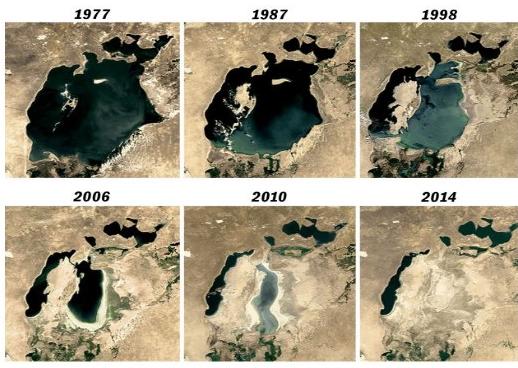
The drying-out of the Aral Sea. Taken from the National Action Plan to mitigate
the effects of SDS in Uzbekistan for 2021-24
#Sandandduststorms #SDS #UNCCD #CAREC #DroughtandSDS #Central Asia
Sand and dust storms (SDS) occur when winds blow over dry land with sparse or absent vegetation. SDS are a global hazard and are especially severe and frequent in regions where conditions for their occurrence are favourable.
Central Asia is one of the regions that are afflicted by SDS. Exhibiting an arid to semi-arid climate and home to vast expanses of dry land, the region needs to adapt modern-day approaches to managing the risk of SDS and mitigating their impact.
Until recently, the Republic of Uzbekistan, where arid and semi-arid areas account for 70% of the territory, did not have a dedicated policy that would deal with the adverse consequences of SDS. On the initiative of the Secretariat of the United Nations Conventions to Combat Desertification (UNCCD) and the Government of Uzbekistan represented by the State Committee on Forestry, leading experts from the National Working Group developed a National Action Plan (NAP) for mitigating the effects of SDS for 2021-2024. This work was coordinated by the Regional Environmental Centre for Central Asia (CAREC).
The NAP will boost Uzbekistan’s preparedness to and resilience against SDS, which will contribute to the country’s sustainable economic development. Dealing with SDS effectively is especially important considering the vulnerability this hazard creates for people living in some of Uzbekistan’s regions, notably the Khorezm province and the Republic of Karakalpakstan. In these two regions, SDS air-borne dust is a significant threat to people’s health. Experts consider 37% and 45% of the medically observed population in the Khorezm province and Karakalpakstan respectively to be vulnerable to diseases aggravated by SDS. In numbers, this amounts to more than 900 thousand people.
In addition to posing a public-health threat, SDS reduce productivity in a number of areas crucial for numerous communities in Uzbekistan and all across the globe, including agriculture, cattle-farming, fishing, etc. SDS pollute open water sources and inhibit the use of clean energy.
The National Action Plan is a stepping stone to tackling all these issues and developing modern tools that would help Uzbekistan deal with the risk of SDS and its consequences. The document includes a comprehensive analysis of the of SDS emergence across the country and outlines measures to mitigate the social and economic impacts of SDS.
The National Action Plan is in line with Uzbekistan’s strategic sustainable development goals and provides a valuable addition to the country’s existing institutional framework dedicated to dealing with SDS. It summarizes the country’s ongoing cooperation with international partners in the management of SDS and suggests avenues for improving the participation of non-governmental organizations and local communities (water users associations, rural residential communities, NGOs, farmer and dekhan farms councils) in the implementation of national programs on drought and SDS management.
The development of the National Action Plan was carried out in the framework of the project titled “Regional approaches in combating sand and dust storms and drought” implemented by CAREC. The project is part of the UNCCD Secretariat’s global efforts in tackling desertification/land degradation and aims at involving multiple stakeholders, including international organizations, governments, experts and local communities, in finding innovative solutions to deal with drought and SDS.
Effectively combatting desertification is a common goal that could be reached through cooperation and strong community involvement. Being vulnerable to desertification, Central Asia needs to deal with this hazard as a region fostering large-scale cooperation between countries. Ahead of 17 June, the World Day to Combat Desertification and Drought, CAREC would like to emphasize the vital importance of combatting desertification for the global community.
Information about the Project:
In January 2020, in all five countries of Central Asia with the financial support of the Secretariat of the United Nations Convention to Combat Desertification (UNCCD) the project “Regional approaches in combating sand and dust storms and drought” was launched. The project is implemented by the Regional Environmental Centre for Central Asia (CAREC), which works in close cooperation with designated national institutions and UNCCD National Focal Points in each of five countries.
The main objective of the project is to assist Member States in improving their preparedness and resilience to droughts and FDP, and to enable coordinated action and data exchange at national and regional levels.
You can learn more about the Project and its activities here:
- http://carececo.org/main/activity/projects/droughtSDS/
-
https://www.unccd.int/conventionregions/regional-approacht-sahes-combat-drougnd-and-dust-storms-central-asia
